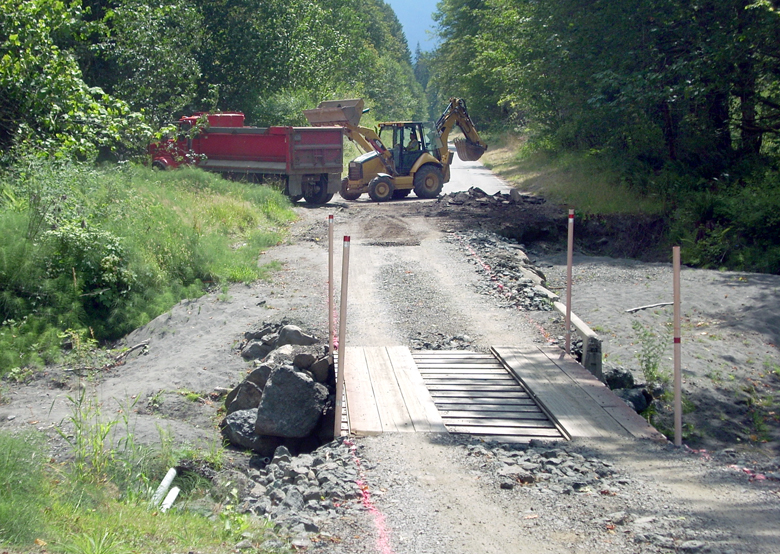OLYMPIC NATIONAL PARK — Work will begin Monday to create a one-lane bridge that allows visitors to drive to areas of Olympic National Park that have been inaccessible to vehicles since November.
Repair of the 90-foot washout of the Olympic Hot Spring Road near the Elwha Campground was held up by permits, according to Barb Maynes, Olympic National Park spokeswoman.
Now the necessary permits are in hand and the contractor is ready to begin work on a temporary bridge for vehicles heading to such areas as the Glines Canyon overlook and Olympic Hot Springs.
The temporary bridge — which would be used for five to seven years while officials consider a long-term solution — is expected to be finished by early October.
Although hikers and bicyclists have been able since February to use a trail to access areas west of the washout, Olympic Hot Springs Road has been closed to vehicles at the park gate at Madison Falls, 1 mile north of the washout.
As of Monday, that closure will be in place for all — vehicles, hikers and bicyclists. The Madison Falls trail and parking area will remain open, but entry beyond that point will be closed, said Barb Maynes, park spokeswoman.
During the closure, crews will work seven days a week to complete in-water work on a deadline.
“It’s going to be fast and furious work,” Maynes said.
The first work will be in Sanders Creek. Such in-water work must be completed by Aug. 15, when a “fish window” — a time in spawning fish must be protected according to state regulations — will open.
“If we want to get the project done this year, we have to get the in-water work done by Aug. 15,” Maynes said.
Acting Superintendent Lee Taylor said that crews will work as quickly as possible to complete the in-water work before spawning fish return in mid-August, “so we are taking steps to avoid any interruptions to their work.
“As much as we regret the inconvenience of closing pedestrian access, any construction slowdowns jeopardize the chances of reopening the road to vehicles this year.”
If the first deadline is met, park officials may consider opening the road to hikers on a limited basis, such as on weekends, Maynes said.
“We realize it’s a big inconvenience. We don’t like having to ask the public to stay out,” she said.
The National Park Service had requested $424,000 for a one-lane bridge.
Everything fell into place just last week, Maynes said.
The most extensive permitting process was for the in-water work in Sanders Creek, a tributary of the Elwha River.
When the river flooded Nov. 17, it was across a wide expanse.
“A lot of water flooded Sanders Creek and that is what washed out the road,” Maynes said.
A second flood that occurred Dec. 8 and Dec. 9 caused additional damage to the road and nearby Elwha Campground.
An aquatic resources permit from the Army Corps of Engineers was needed for the work in Sanders Creek, Maynes said.
“To get that permit, we had to work though the National Marine Fisheries Service and a number of agencies to make sure anything we were going to be doing would have the least impact on environment,” she said.
At the same time, the contractor informed the park it could provide all necessary materials, Maynes said.
“If we couldn’t have been able to do that, we wouldn’t have been able to start now. We would have had to start next year.”
In the first phase, workers will build an abutment on one side to make a solid foundation for the bridge, which will be second phase.
That bridge will stay in place while officials watch to see what the Elwha River, now unleashed from a century of dams, will do before they decide on a permanent replacement.
“It’s been 100 years. All the campgrounds and roads were built during the time it was dammed,” Maynes said.
“We haven’t seen it normally functioning in its flood plains,” she said.
The temporary bridge will give officials “time to look at the valley in a holistic way and see how river is acting now that the dams are gone,” she said.
“It is anticipated that the river could move more, especially during winter storms.”
However, Maynes doesn’t believe that the removal of the two Elwha River dams, which was finished in 2014, caused the problem.
Last winter was especially severe, she said.
Precipitation in the Elwha Valley last winter measured 138 percent of normal, making it the fourth wettest winter in the 75-year record at the Elwha Ranger Station, Maynes said.
“In the four-month period from November through February, the Elwha River experienced a 25-year flood, a 10-year flood, two five-year floods and one two-year flood,” she said.
“Other roads in the park washed out during the winter,” she said.
And it isn’t the first time the Elwha has flooded and taken out chunks of roadway.
“I don’t think it happened because the dams were out,” Maynes said.
She suggested that those interested in visiting sites related to Elwha River restoration and dam removal stop at the Elwha River Interpretive Kiosk at state Highway 112 and Lower Dam Road.
Foot access to the former site of the Elwha Dam is also available from that location.
For more information about the park, see www.nps.gov/olym.
________
Executive Editor Leah Leach can be reached at 360-417-3530 or at lleach@peninsuladailynews.com.
